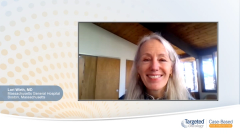
Second-Line Treatment and Future of Treating Advanced RAI-Refractory DTC
Lori Wirth, MD, discusses second-line treatment in relation to the patient case, and concludes the discussion with a look at emerging treatment options and the future of treating advanced RAI-refractory DTC.
Episodes in this series

Case: A 64-Year-Old Woman with DTC
Initial presentation
- A 64-year-old woman presents with a painless “lump on her neck” with occasional swelling. She states she noticed this just a few days after returning from vacation.
- PMH: Hyperlipidemia managed with medication; COPD
- PE: palpable, non-tender solitary right-of-the midline neck mass; mobile supraclavicular mass on the same side; otherwise unremarkable
Clinical workup and initial treatment
- Labs: TSH WNL
- Ultrasound of the neck revealed a 3.3-cm suspicious right mass in the lobe of the thyroid; 2 suspicious supraclavicular lymph nodes (LNs), largest 2.0 cm in size.
- Ultrasound-guided FNAB of the thyroid mass and the largest LN confirmed papillary thyroid carcinoma.
- Patient underwent total thyroidectomy with central compartment node dissection and right selective neck dissection.
- Pathology: 3.0-cm papillary thyroid cancer, columnar cell variant; 4/14 lateral positive LN, 3/3 central positive LN
- Largest lateral node was 2.2 cm with no extra-nodal extension
- Margins were negative
- Microscopic extrathyroidal extension present
- Probable stage II; T2N1bM0 papillary thyroid cancer
Subsequent treatment and follow-up
- She was treated with radioactive iodine 150 millicuries
- Whole body scan showed uptake in the neck, consistent with remnant thyroid tissue
- She was started on levothyroxine suppression therapy
- Follow-up at 6 months
- TSH 0.1 µU/mL, thyroglobulin 24 ng/mL (negative anti-thyroglobulin antibodies)
- Chest CT scan showed 8 small bilateral lung nodules only several mm in size
- Next-generation sequencing was negative for mutations, rearrangements
- Follow-up CT chest scan and blood tests 3 months later
- Thyroglobulin increased
- Lung nodules had increased by up to 1 cm in size
- Lenvatinib 24mg po qd was initiated
This is a video synopsis/summary of a Case-Based Peer Perspective featuring: Lori Wirth, MD.
Wirth revisits the case of the 64-year-old woman with rapidly progressive radioactive iodine (RAI)–refractory differentiated thyroid cancer (DTC) with lung metastases who started treatment with Lenvatinib but still progressed.
The COSMIC-311 trial investigated cabozantinib compared with placebo in patients whose disease progressed on first-line or second-line therapy. Cabozantinib significantly improved progression-free survival (PFS) compared with placebo (median PFS not reached vs 1.9 months) and demonstrated a 15% objective response rate. Cabozantinib is now considered the second-line therapy of choice for patients with disease progression on a first-line VEGFR multikinase inhibitor with RAI-refractory DTC.
Future strategies for treating RAI-refractory DTC include combining checkpoint inhibitors with VEGFR multikinase inhibitors, with ongoing studies investigating combinations such as lenvatinib plus pembrolizumab and surufatinib plus toripalimab. Other VEGFR multikinase inhibitors, such as pazopanib, have shown activity in the second-line setting. Targeting the MAP kinase pathway is another promising area, given the high rates of BRAF V600E mutations in papillary thyroid cancers and RAS mutations in follicular thyroid cancers. Drugs targeting BRAF or RAF dimers, currently studied in melanoma and colorectal/pancreatic cancer, may have relevance in patients with thyroid cancer harboring molecular alterations in the MAPK pathway.
Video synopsis is AI-generated and reviewed by Targeted Oncology® editorial staff.










































